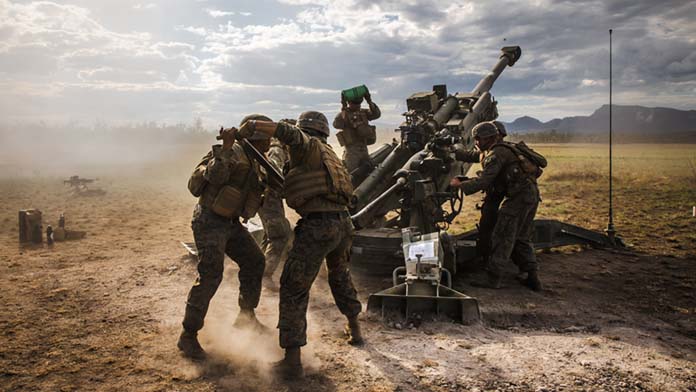Anthony Albanese is locking in the biggest US military build-up here since the Second World War, while establishing Australia as a major arms manufacturer.
At the end of July, there were a string of new announcements out of the 2023 AUSMIN meeting.
AUSMIN is the Australia-United States Ministerial Consultations where government ministers from the US and Australia meet to discuss security arrangements between the two countries. Australia’s Foreign Minister Penny Wong and Defence Minister Richard Marles joined US Secretary of State Anthony Blinken and Defense Secretary Lloyd Austin.
This year’s was the 33rd meeting. As the US Department of Defense put it, the two country’s ministers in attendance “determined that the Unbreakable Alliance between the United States and Australia has never been stronger”.
The Australian and US governments agreed to jointly survey the Scherger and Curtin Australian Air Force bases for upgrades and “hardening”. The US will also continue funding upgrades of Air Force bases at Darwin and Tindal. These upgrades will enable the bases to house and deploy six US B-52 strategic bombers each.
B-52 bombers can carry nuclear weapons as well as dozens of other missiles. The US will not disclose to Australia whether any bomber is carrying nukes at any particular time.
A salivating US Air Force spokesmen told Four Corners that “the ability to deploy US Air Force bombers to Australia sends a strong message to adversaries about our ability to project lethal air power”.
There will also be more regular and longer visits of US nuclear submarines to Australia starting this year, with a focus on the HMAS Stirling naval base in Western Australia. That’s part of the AUKUS agreement, getting Australian personnel up to speed on running these killing machines before Australia gets its own.
Also discussed were regular visits by US army watercraft, US navy patrol and reconnaissance aircraft, and the US will investigate positioning arms caches and logistical support bases here.
And US intelligence officials will now be based in a Combined Intelligence Centre in Canberra—giving them “seamless” integration of intelligence between US and Australia.
Defence manufacturing
AUSMIN also committed the US to assisting the Australian defence manufacturing sector, with an initial focus on the speeding up the co-production of Guided Multiple Launch Rocket Systems by 2025.
The US also announced it will reform export laws so they can transfer instructions to Australia for the production of M795 projectiles, used heavily in the Ukraine war.
Australia is more and more tied to the US military—with the US presence in Australia set to reach its highest level since the Second World War.
AUKUS and the AUSMIN commitments are turning Australia into a launch pad for war on China.
This does not represent Australia’s subordination to US interests. It is something the Australian ruling class has been pursuing for decades, continuing Australia’s long trend of trying to drag its big imperialist partner into a greater commitment to the region to protect its own interests.
After Liberal Prime Minister John Howard was elected in 1996, Australia’s ambassador to the US offered to build training facilities for US marines in northern Australia—but was turned down.
Fast forward more than a decade, and US President Barack Obama began the “pivot to Asia”—to concentrate on containing China.
Since then we have seen a major build up of US military capabilities on the continent.
Also from the US perspective—bases installed in Australia provide important redundancy in case US bases in Okinawa and Guam are knocked out by China’s military.
Talisman Sabre
Talisman Sabre 2023, the biennial war games involving joint exercises between the Australian and US military around Shoalwater Bay in central Queensland, was the largest ever.
This year saw 30,000 troops from 13 countries involved—with participation from Germany, Japan, Papua New Guinea, Fiji and Tonga for the first time.
The war games served to improve inter-operability of military forces and as a demonstration of force aimed at rivals, in particular Russia and China.
They also showed US efforts to consolidate alliances against China. In the same week the media reported that the US was encouraging South Korea and Japan to pledge to consult each other about responding if either faced attack.
This comes following the AUKUS agreement, cementing closer military ties between the US, UK and Australia, along with the disgraceful $368 billion spending on nuclear submarines.
We need to oppose Australia’s military buildup and the efforts to increase the US military presence here. This only inflames regional tensions and increases the threat of war with China.
Ordinary people in the US, Australia, and China have far more in common with each other than with the rulers driving us to war.
By Jayden Rivers






